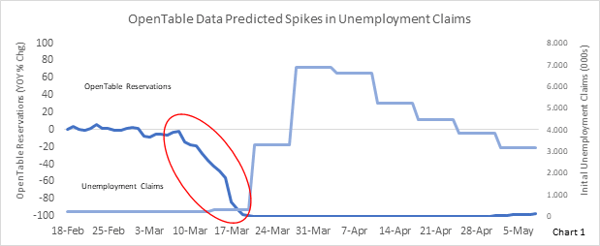Unfamiliar Data in an Unfamiliar World - Revisited
What was the idea of the original blog post?
On 27th March 2020, we published a blog discussing ways to use alternative data sources to understand the impact of Covid-19 on business performance, without having to wait for official government metrics to be released. We suggested using data from OpenTable as an immediate substitute for forecasting as this was available on a next-day daily cadence, whereas governmental sources are lagged by weeks or even months. Was the OpenTable data suitable as a labor market alternative? Let’s examine it.

Did it work?
We projected unemployment figures would increase dramatically in the coming weeks due to lags in the data and problems in the system. Reservations within OpenTable’s system had effectively gone to 0 in the span of two weeks, yet unemployment figures were significantly lagged to the extent that they showed little to no effect. Since the end of March, unemployment claims have skyrocketed across the United States (Chart 1) as businesses have been forced to remain closed.

Reservations, in this case, were weeks ahead of the traditional data source. None of this is new information, it has been repeated ad nauseum for the last 2 months, but the importance of finding proxy data sources in times of uncertainly has never been more imperative. Businesses who used the reservation data as a placeholder for the macroeconomy were able to control for Covid-19’s effects weeks before official governmental sources were available, and could make adjustments to their marketing plans in real time, based on the real world data.
Want to know more?
-2.png?width=200&height=200&name=Untitled%20design%20(40)-2.png)
-2.png?width=50&height=50&name=Untitled%20design%20(40)-2.png)








